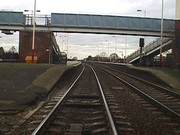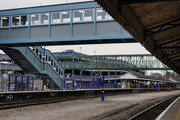Disabled People Access
Disabled People Access
Hi All,
Having just started to build my layout all sorts of issues come up, wiring, track, buildings etc. Now I've just finished modelling a two platform station with subway and bridge and thought 'How do disabled people get to platform 2. The only way I can see is to install a lift on each side with spanning bridge between, in other words, a total redesign & build. I would like to hear what others have done in this regard.
Best Rgds,
Dave R.
Having just started to build my layout all sorts of issues come up, wiring, track, buildings etc. Now I've just finished modelling a two platform station with subway and bridge and thought 'How do disabled people get to platform 2. The only way I can see is to install a lift on each side with spanning bridge between, in other words, a total redesign & build. I would like to hear what others have done in this regard.
Best Rgds,
Dave R.
Re: Disabled People Access
How about elevators down to the subway? Just needs entrances next to the subway steps.
Glencairn
Glencairn
To the world you are someone. To someone you are the world
I Cannot Afford the Luxury of a Negative Thought.
I Cannot Afford the Luxury of a Negative Thought.
- Walkingthedog
- Posts: 5119
- Joined: Thu Oct 04, 2018 5:51 pm
- Location: HAZLEMERE, BUCKS.
- Contact:
Re: Disabled People Access
I don’t have a station on my layout but in real life a footbridge with lifts seems to be the norm. A few years ago if a wheelchair user wanted to cross the track to another platform they went own the ramp over the crossing and up the ramp. Depends what period you are modelling.
Nurse, the screens!
Re: Disabled People Access
Hi All,
Putting a lift access down to the subway, yes I can just about fit that in, I've got about 45mm to the end of the platform.
On my larger 4 road station, I think the bridge idea would work well, just at the planning stage with that station. As a side issue, I know what you mean about going down the ramp and across the rails, but didn't they need to get station staff to assist in that?
Long live Major Bloodnok!!
Best Rgds,
Dave R.
Putting a lift access down to the subway, yes I can just about fit that in, I've got about 45mm to the end of the platform.
On my larger 4 road station, I think the bridge idea would work well, just at the planning stage with that station. As a side issue, I know what you mean about going down the ramp and across the rails, but didn't they need to get station staff to assist in that?
Long live Major Bloodnok!!
Best Rgds,
Dave R.
Re: Disabled People Access
Station design and disabled access has changed dramatically over the years.
When stations were first opened in Victorian times scant consideration was given to access by persons with disabilities. It was extremely difficult for anyone with a wheelchair to get on to a train without assistance. Crossing from one platform to another was by a 'barrow crossing' which was provided to help staff take luggage and parcels across the rails, and anyone with a wheelchair had to travel in the guards van. Passengers were discouraged from using the barrow crossing, and normally needed to be taken over by a porter. Similarly perambulators carrying children were dealt with in much the same way.
Passenger accessible lifts were rare, although at stations where large amounts of mail or parcels were handled the railway companies did provide them, these were not readily available to the public, who had to be accompanied by a member of staff. Many of these lifts had heavy folding gates which were manually opened and closed, and were very rough and ready.
Before Beeching most stations were manned so there would be a staff member to assist. However as more and more stations were de-staffed, and many barrow crossings were removed on the grounds of safety it became impossible for disabled persons to use the railway.
Things remained very much the same until the fourth quarter of the 20th Century when awareness of the needs of persons of reduced mobility increased and legislation started to appear requiring transport operators to make provision for disabled persons.
Another feature which has appeared in recent times is the footbridge which has a ramp incorporated which permits travellers on wheels to use it.
These can be very substantial structures. Like this one at Church Fenton.

When stations were first opened in Victorian times scant consideration was given to access by persons with disabilities. It was extremely difficult for anyone with a wheelchair to get on to a train without assistance. Crossing from one platform to another was by a 'barrow crossing' which was provided to help staff take luggage and parcels across the rails, and anyone with a wheelchair had to travel in the guards van. Passengers were discouraged from using the barrow crossing, and normally needed to be taken over by a porter. Similarly perambulators carrying children were dealt with in much the same way.
Passenger accessible lifts were rare, although at stations where large amounts of mail or parcels were handled the railway companies did provide them, these were not readily available to the public, who had to be accompanied by a member of staff. Many of these lifts had heavy folding gates which were manually opened and closed, and were very rough and ready.
Before Beeching most stations were manned so there would be a staff member to assist. However as more and more stations were de-staffed, and many barrow crossings were removed on the grounds of safety it became impossible for disabled persons to use the railway.
Things remained very much the same until the fourth quarter of the 20th Century when awareness of the needs of persons of reduced mobility increased and legislation started to appear requiring transport operators to make provision for disabled persons.
Another feature which has appeared in recent times is the footbridge which has a ramp incorporated which permits travellers on wheels to use it.
These can be very substantial structures. Like this one at Church Fenton.

LC&DR says South for Sunshine
Re: Disabled People Access
There are still places where wheelchair users can't get to all platforms. They have to remain on the train and go to a station where it is possible to cross, either by bridge or subway. Those wishing to travel from the station need to travel from the platform they do have access to and change at the next station to travel back towards their destination.
As such, simply placing miniature signs could be thought of as 'prototypical' of some stations.
As such, simply placing miniature signs could be thought of as 'prototypical' of some stations.
Re: Disabled People Access
Only 78 of London Underground's 270 stations are wheelchair friendly. And still many main line stations are difficult to access.
The train operator has to provide a taxi from a non-accessible station to the nearest accessible station, however they usually demand 24 hours notice.
The train operator has to provide a taxi from a non-accessible station to the nearest accessible station, however they usually demand 24 hours notice.
LC&DR says South for Sunshine
Re: Disabled People Access
Hi LC&DR,
Your reply was pretty informative and I thank you for that. I did try to do a bit of my own research by looking at images/pictures from various stations but of the 6 I've looked at so far, non show these lifts or footbridges with this access. I would have thought that they would be first in line to show the public what they have to offer for those less able bodied of us.
Best Rgds,
Dave R.
Australia
Your reply was pretty informative and I thank you for that. I did try to do a bit of my own research by looking at images/pictures from various stations but of the 6 I've looked at so far, non show these lifts or footbridges with this access. I would have thought that they would be first in line to show the public what they have to offer for those less able bodied of us.
Best Rgds,
Dave R.
Australia
- Walkingthedog
- Posts: 5119
- Joined: Thu Oct 04, 2018 5:51 pm
- Location: HAZLEMERE, BUCKS.
- Contact:
Re: Disabled People Access
I would say all stations had access to all platforms for anybody but for those unable to use a subway or footbridge they would have to cross the track on the provided crossing with a member of staff. Our local station recently closed the subway and opened a new footbridge with lifts.
The green bridge was temporary while they constructed the new bridge.

The green bridge was temporary while they constructed the new bridge.

Nurse, the screens!
Re: Disabled People Access
How 'able bodied' people cross the line at Santa Apolonia Railway Station, Lisbon, (instead of walking round).
Glencairn
Glencairn
To the world you are someone. To someone you are the world
I Cannot Afford the Luxury of a Negative Thought.
I Cannot Afford the Luxury of a Negative Thought.